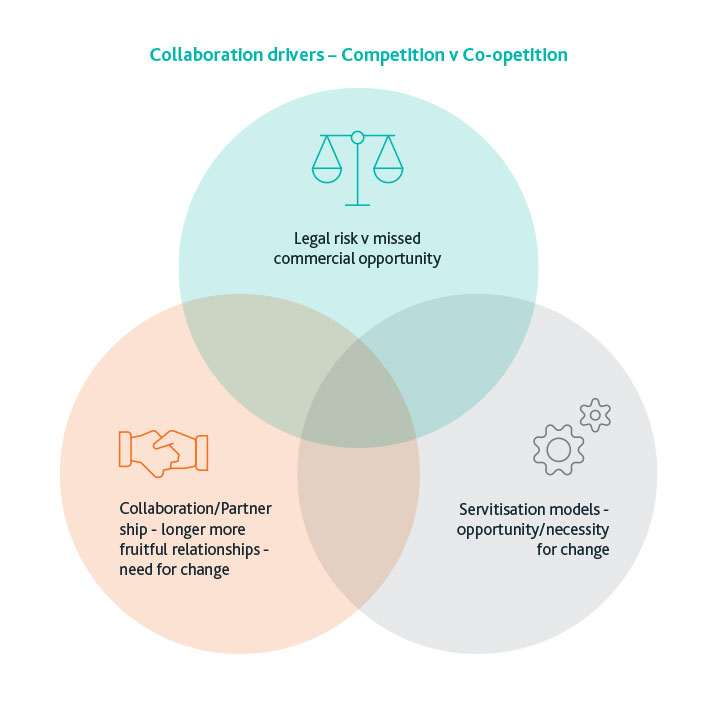Out-Law Analysis 7 min. read
Collaborating on mobility while remaining competitive

16 Dec 2020, 11:13 am
Many innovators and disruptors, from the technology giants to start-up ride-hailing businesses, are now entering the automotive market, bringing new insights and technologies and offering opportunities and challenges for the traditional manufacturers.
Collaboration requires a degree of openness that is unusual in existing supply chain models. Businesses must be prepared to share more, and to be honest about the risks and competing interests of doing so, to be successful. Effective data sharing and more licensing of intellectual property (IP) will be crucial.
The need to collaborate
Traditionally, car manufacturers and technology companies have each had very distinct areas of expertise and operation. As connected mobility relies on a wide variety of technologies, increasingly these industries have to cooperate and work together.

Advanced driver assistance (ADA) systems and other vehicle technologies have their own operating systems, software and middleware. Original equipment manufacturers (OEMs), famed for their highly valued hardware and engineering, need to gain the expertise of software developers and technology operators to embrace the development of new vehicles, connected infrastructure and mobility as a service (MaaS). No single entity has all the necessary expertise and resources.
Manufacturers will need to assess their skill sets and any gaps needing filled. Some of these will be filled by recruiting the required expertise in-house, but others will be met through collaboration with other automotive, technology and related businesses.
Deciding on the form and nature of the collaboration will be important. Different models require different types and degrees of collaboration. Examples include:
- acquisitions for example the recent $1 billion acquisition of car start-up Zoox by Amazon;
- mergers, for example the merger between FCA and PSA Group, which was struck to position the new entity at the forefront of sustainable mobility;
- joint venture arrangements, for example Ventic, the partnership between VW and Aeris;
- investment, for example Toyota's $1bn investment into ride-hailing service Grab.
Successful collaboration can also take place at a less formal level, for example contracts to collaborate on specific projects.
Managing IP rights and risks
OEMs have always had to grapple with the IP rights and interests of supply chain participants and third parties, but as we see more collaboration this will become more significant. The legal issues should not be ignored, but used to create greater opportunity and value.,
Collaboration requires the careful handling of IP rights – particularly determining whether, and the terms on which, the parties' existing IP rights ('background IP') will be shared; and the ownership, control and user rights of the parties in relation to IP developed as part of the collaboration ('foreground IP'). Due diligence in relation to the other party's IP is also strongly recommended. Deciding who owns the background and foreground IP, rights of use and rights to commercialise, license and assign such rights, both during the collaboration and following termination, will be essential.
Co-ownership of IP may appear to be a fair, attractive solution, but can be problematic in reality. Joint or co-ownership of IP has a different meaning depending on the nature of the IP rights in question, and depending on the country in which the IP was developed. While it generally allows each party rights of use without the need for consent from the other, joint ownership may require the parties to share revenue generated from the use of the IP and certainly does not always allow the parties to license the IP rights or assign their share without the consent of the other. Multiple owners can also mean there is no clear responsibility for protecting and enforcing the IP, leading to missed opportunities to register, maintain and enforce the foreground IP.

Cerys Wyn Davies
Partner
Data trusts are a way of sharing data in the spirit of openness and exploration
Alternatives to co-ownership should also be considered. For example:
- one party owns the foreground IP, acquiring the IP rights of its collaborator(s) by assignment;
- the owning party takes on the responsibility for protecting and enforcing the IP;
- the owning party then licenses the IP to its fellow collaborator(s) on agreed terms covering field of use, whether the licence is exclusive or non-exclusive, revenue sharing, rights to sub-license and what happens on termination.
Whatever IP arrangement is agreed, it is essential that the collaboration agreement between the parties clearly governs all of these issues.
Managing data sharing
The use of data is essential to the connectivity required across the sector, particularly for MaaS; increasingly eclipsing the value of hardware. Legal issues associated with data must be properly addressed. In particular, the processing of personal data poses a risk of cyber and other data breaches, especially when shared between collaborators. Having the appropriate data sharing agreements and policies in place will be vital to managing this risk and avoiding compliance breaches, hefty fines and claims from individuals.
Wejo, a UK tech company, is currently the market leader in connected vehicle data with more than 10 million vehicles on its platform in the US alone. It has now supercharged its offering with the launch of its new Neutral Server Plus service, allowing third parties access to connected vehicle data. Daimler was the first company to sign up to this service, last December.
Data trusts are a way of sharing data in the spirit of openness and exploration. Data trusts provide a legal structure for the independent stewardship of data. They are a flexible and sophisticated form of data sharing arrangement where the parties have a common and defined purpose for sharing the data. The trust can be narrow or wide depending on the underlying aims and is subject to a robust governance regime, which should reassure stakeholders that the data will only be used appropriately and for the intended purpose.
IP licensing
As no single entity will hold all of the IP rights essential for the manufacture, supply and operation of a connected vehicle, there will be an increasing need and opportunity for IP licensing.
The possibility of owning a full suite of IP rights is improbable. However, when considering whether to engage in the often expensive R&D process or license a portfolio of rights, manufacturers may find that holding a strong portfolio of their own is a useful tool in cross-licensing negotiations.
Questions have arisen as to where SEPs should be licensed in the supply chain – by OEMs, relevant parts suppliers or end suppliers – and what amounts to a fair, reasonable and non-discriminatory (FRAND) licence in this context
There may be a number of standards essential patents (SEPs) for which a licence will need to be secured. Questions have arisen as to where SEPs should be licensed in the supply chain – by OEMs, relevant parts suppliers or end suppliers – and what amounts to a fair, reasonable and non-discriminatory (FRAND) licence in this context. Where claims arise from patent owners that a SEP FRAND licence must be obtained, supply chain participants must consider how such claims should be addressed including who should lead the defence of the claim; who should bear the cost; and how negotiations and settlement discussions should be handled.
In an ongoing SEP patent licensing dispute between Nokia and Daimler, Nokia's patent for certain telecommunications technology used in cars for e-connectivity has been found by the Mannheim Regional Court to be infringed, and an injunction potentially preventing sales of Mercedes vehicles in Germany has been issued. This dispute, which has now been referred to the Court of Justice of the EU (CJEU), could have enormous repercussions for the automotive industry.
Drivers of collaboration
Mobility as a service
Manufacturers and tech businesses are also joining forces to embrace new digital services. Ride-sharing services are a logical development from autonomous and connected vehicles. In the future, there will be no need for everyone to own their own autonomous vehicle, meaning the business model will have to change out of necessity.
As we move to a model of ride-sharing services, tech giants have the advantage of experience, access to technology and funds. Collaborations are already beginning to form in this space, such as Toyota with Grab and GM with Lyft. This type of model caters for a new type of consumer - younger, tech-savvy and seeking instant results.
For example, China has recently launched a new blockchain-based initiative to support car rental, following a collaboration between Alipay and Wukong Car Rental. The model, which makes use of Alipay's face recognition payment system, completes the process without a human attendant. The project's first kiosk was set up in January 2020.
Manufacturers are now looking to contract directly with end customers, with new legal requirements to consider. These should be borne in mind at the outset of any collaboration to manage that risk.
More fruitful relationships
Successful collaborations will often involve sharing of trade secrets and the risk of loss of control, misuse and leakage of those secrets into the public domain. However, if shared properly, this can build trust in a relationship and avoid potential disputes as to whether material shared amounted to a trade secret or not - for example, because the information was not valuable, or not in fact secret.
The agreement between the parties must build in the correct level of specification and essential legal obligations, in particular as regards use and publication. Absolutely essential is the plan if one party seeks to exit, even if parties entering into a new collaboration do not want to contemplate this. Post-termination rights and obligations should be agreed at the outset and specified in the contract forming the collaboration. For example, will the parties each be able to use their own and the other party's background IP and the foreground IP generated by the collaboration and, if so, for what purposes? Ongoing user rights may depend on the grounds of termination of the arrangements, and trade secrets should be protected to avoid inadvertent misappropriation.
Behavioural contracting: legal and cultural change
Collaborations often fail before they begin. When parties get too bogged down in the detail - in particular, looking to minimise and transfer risks and liabilities - it is easy to lose sight of the aims and the mutual benefits of collaboration.

Cerys Wyn Davies
Partner
Protecting your assets when collaborating is essential to safeguarding shareholder value and your business
A degree of openness and willingness to share risk and reward is essential to a successful collaborative relationship. A number of vehicle manufacturers are taking the stance that they will be more forthcoming with their IP in the interests of accelerating development. For example:
- Tesla, in 2014, made a pledge that it would "not initiate patent lawsuits against anyone who, in good faith, wants to use our technology".
- BMW collaborated with Microsoft last year on an 'open manufacturing platform' in order to accelerate future industrial IoT developments and "create new opportunities for collaboration across the entire manufacturing value chain".
- NVIDIA confirmed last year that it would provide developers of autonomous vehicles with access to its pre-trained AI models and training code. Its aim was to accelerate autonomous vehicles worldwide by "enabling shared learning across companies and countries, while maintaining data ownership and privacy".
The perception that sharing is the key to accelerating innovation is seemingly widespread.
There is no easy answer to the question of how to share and collaborate while remaining competitive. In some cases, wide and open source models of sharing may be appropriate, while in others the sharing will be limited to one or a limited number of contracted collaborators. However, in every case, it must be carefully decided what IP and related materials, designs and technologies will be made available to others and on what terms. Protecting your assets when collaborating is essential to safeguarding shareholder value and your business.
Co-written by Katy Bourne of Pinsent Masons.




